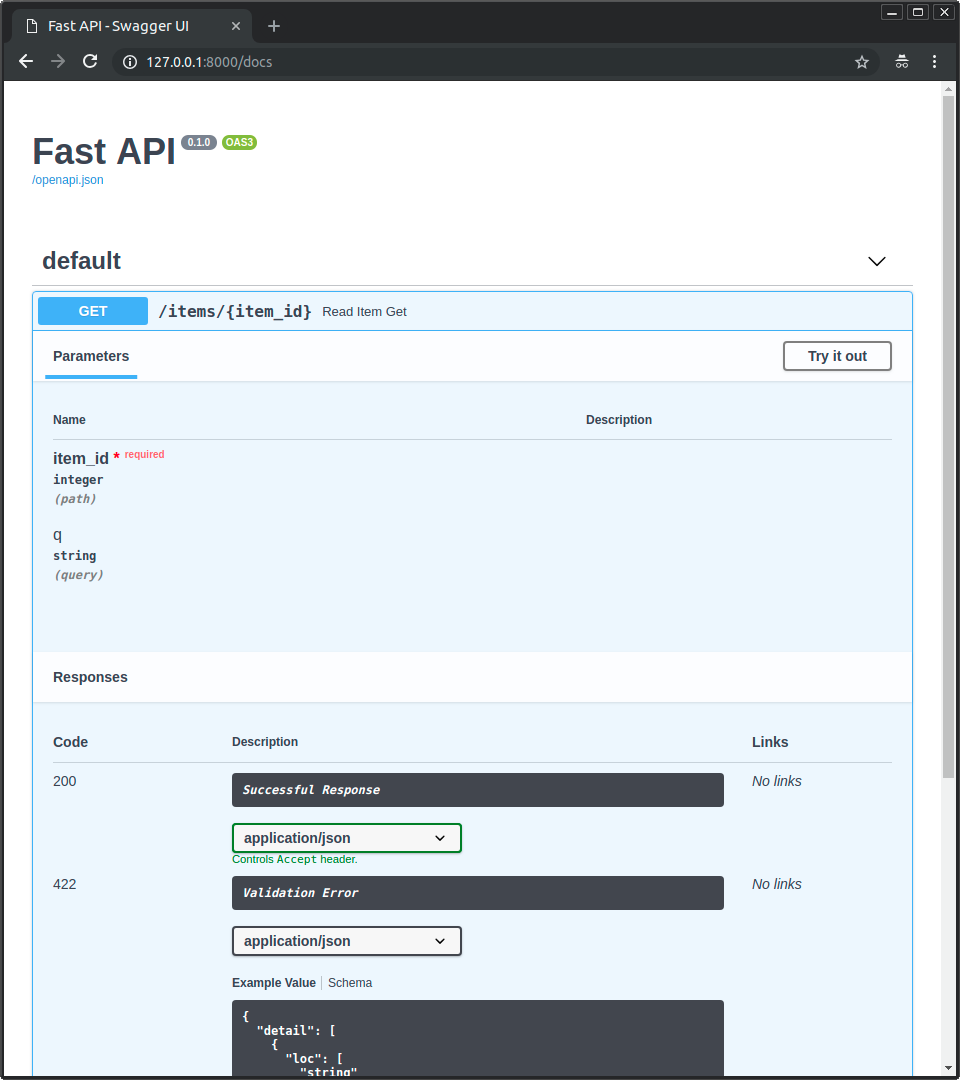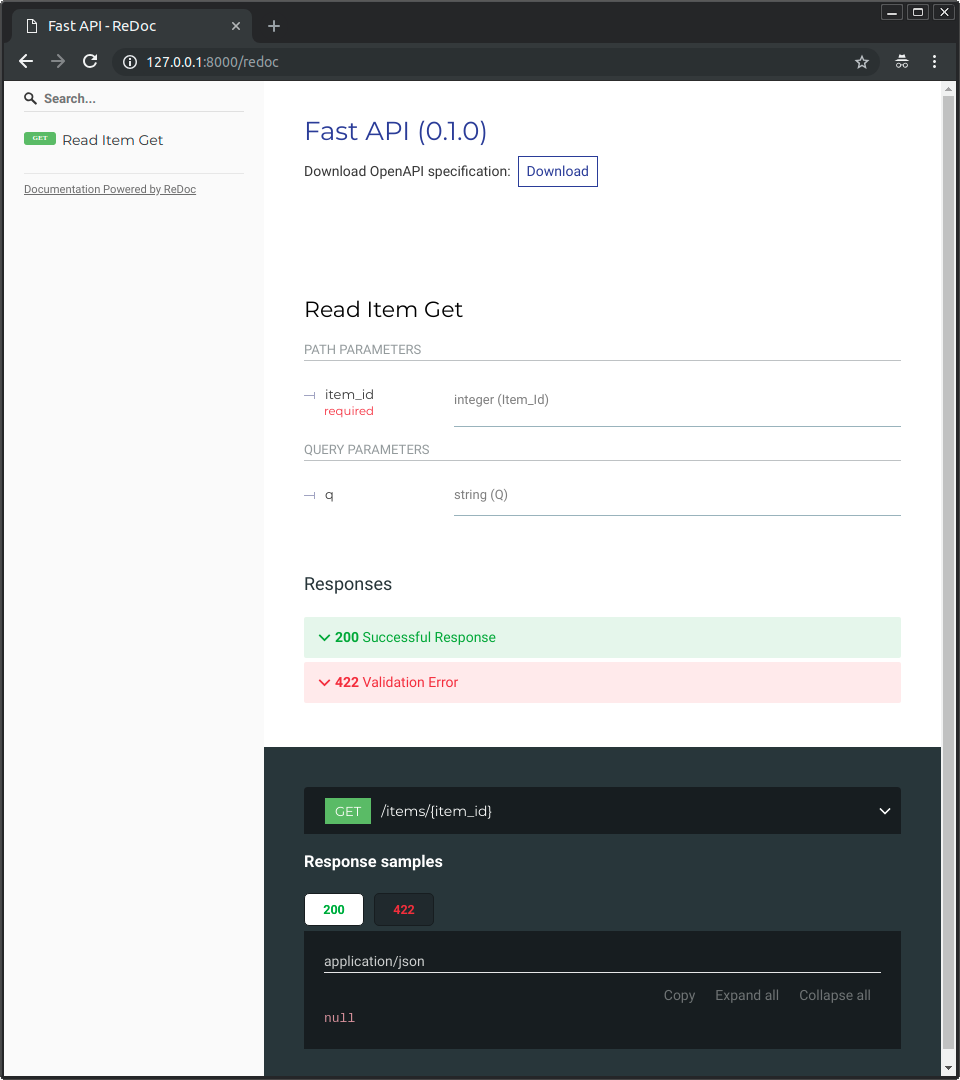第一步¶
最簡單的 FastAPI 檔案可能看起來像這樣:
from fastapi import FastAPI
app = FastAPI()
@app.get("/")
async def root():
return {"message": "Hello World"}
將其複製到一個名為 main.py 的文件中。
執行即時重新載入伺服器(live server):
$ <font color="#4E9A06">fastapi</font> dev <u style="text-decoration-style:single">main.py</u>
<font color="#3465A4">INFO </font> Using path <font color="#3465A4">main.py</font>
<font color="#3465A4">INFO </font> Resolved absolute path <font color="#75507B">/home/user/code/awesomeapp/</font><font color="#AD7FA8">main.py</font>
<font color="#3465A4">INFO </font> Searching for package file structure from directories with <font color="#3465A4">__init__.py</font> files
<font color="#3465A4">INFO </font> Importing from <font color="#75507B">/home/user/code/</font><font color="#AD7FA8">awesomeapp</font>
╭─ <font color="#8AE234"><b>Python module file</b></font> ─╮
│ │
│ 🐍 main.py │
│ │
╰──────────────────────╯
<font color="#3465A4">INFO </font> Importing module <font color="#4E9A06">main</font>
<font color="#3465A4">INFO </font> Found importable FastAPI app
╭─ <font color="#8AE234"><b>Importable FastAPI app</b></font> ─╮
│ │
│ <span style="background-color:#272822"><font color="#FF4689">from</font></span><span style="background-color:#272822"><font color="#F8F8F2"> main </font></span><span style="background-color:#272822"><font color="#FF4689">import</font></span><span style="background-color:#272822"><font color="#F8F8F2"> app</font></span><span style="background-color:#272822"> </span> │
│ │
╰──────────────────────────╯
<font color="#3465A4">INFO </font> Using import string <font color="#8AE234"><b>main:app</b></font>
<span style="background-color:#C4A000"><font color="#2E3436">╭────────── FastAPI CLI - Development mode ───────────╮</font></span>
<span style="background-color:#C4A000"><font color="#2E3436">│ │</font></span>
<span style="background-color:#C4A000"><font color="#2E3436">│ Serving at: http://127.0.0.1:8000 │</font></span>
<span style="background-color:#C4A000"><font color="#2E3436">│ │</font></span>
<span style="background-color:#C4A000"><font color="#2E3436">│ API docs: http://127.0.0.1:8000/docs │</font></span>
<span style="background-color:#C4A000"><font color="#2E3436">│ │</font></span>
<span style="background-color:#C4A000"><font color="#2E3436">│ Running in development mode, for production use: │</font></span>
<span style="background-color:#C4A000"><font color="#2E3436">│ │</font></span>
<span style="background-color:#C4A000"><font color="#2E3436">│ </font></span><span style="background-color:#C4A000"><font color="#555753"><b>fastapi run</b></font></span><span style="background-color:#C4A000"><font color="#2E3436"> │</font></span>
<span style="background-color:#C4A000"><font color="#2E3436">│ │</font></span>
<span style="background-color:#C4A000"><font color="#2E3436">╰─────────────────────────────────────────────────────╯</font></span>
<font color="#4E9A06">INFO</font>: Will watch for changes in these directories: ['/home/user/code/awesomeapp']
<font color="#4E9A06">INFO</font>: Uvicorn running on <b>http://127.0.0.1:8000</b> (Press CTRL+C to quit)
<font color="#4E9A06">INFO</font>: Started reloader process [<font color="#34E2E2"><b>2265862</b></font>] using <font color="#34E2E2"><b>WatchFiles</b></font>
<font color="#4E9A06">INFO</font>: Started server process [<font color="#06989A">2265873</font>]
<font color="#4E9A06">INFO</font>: Waiting for application startup.
<font color="#4E9A06">INFO</font>: Application startup complete.
在輸出中,有一列類似於:
INFO: Uvicorn running on http://127.0.0.1:8000 (Press CTRL+C to quit)
那列顯示了你的應用程式正在本地端機器上運行的 URL。
查看它¶
在瀏覽器中打開 http://127.0.0.1:8000.
你將看到如下的 JSON 回應:
{"message": "Hello World"}
互動式 API 文件¶
現在,前往 http://127.0.0.1:8000/docs.
你將看到自動的互動式 API 文件(由 Swagger UI 提供):

替代 API 文件¶
現在,前往 http://127.0.0.1:8000/redoc.
你將看到另一種自動文件(由 ReDoc 提供):

OpenAPI¶
FastAPI 使用定義 API 的 OpenAPI 標準來生成一個 「schema」 與你的所有 API。
「Schema」¶
「schema」是對某個事物的定義或描述。它並不是實作它的程式碼,而僅僅是一個抽象的描述。
API 「schema」¶
在這種情況下,OpenAPI 是一個規範,它規定了如何定義 API 的 schema。
這個 schema 定義包含了你的 API 路徑、可能接收的參數等內容。
資料 「schema」¶
「schema」這個術語也可能指某些資料的結構,比如 JSON 內容的結構。
在這種情況下,它指的是 JSON 的屬性、資料型別等。
OpenAPI 和 JSON Schema¶
OpenAPI 定義了 API 的 schema。這個 schema 包含了使用 JSON Schema 定義的資料,這是 JSON 資料 schema 的標準。
檢查 openapi.json¶
如果你好奇原始的 OpenAPI schema 長什麼樣子,FastAPI 會自動生成一個包含所有 API 描述的 JSON (schema)。
你可以直接在 http://127.0.0.1:8000/openapi.json 查看它。
它會顯示一個 JSON,類似於:
{
"openapi": "3.1.0",
"info": {
"title": "FastAPI",
"version": "0.1.0"
},
"paths": {
"/items/": {
"get": {
"responses": {
"200": {
"description": "Successful Response",
"content": {
"application/json": {
...
OpenAPI 的用途¶
OpenAPI schema 驅動了兩個互動式文件系統。
而且有許多替代方案,所有這些都是基於 OpenAPI。你可以輕鬆地將任何這些替代方案添加到使用 FastAPI 建置的應用程式中。
你也可以用它自動生成程式碼,讓前端、手機應用程式或物聯網設備等與你的 API 進行通訊。
逐步回顧¶
第一步:引入 FastAPI¶
from fastapi import FastAPI
app = FastAPI()
@app.get("/")
async def root():
return {"message": "Hello World"}
FastAPI 是一個 Python 類別,提供所有 API 的全部功能。
第二步:建立一個 FastAPI 「實例」¶
from fastapi import FastAPI
app = FastAPI()
@app.get("/")
async def root():
return {"message": "Hello World"}
這裡的 app 變數將會是 FastAPI 類別的「實例」。
這將是你建立所有 API 的主要互動點。
第三步:建立一個 路徑操作¶
路徑¶
這裡的「路徑」指的是 URL 中自第一個 / 以後的部分。
例如,在 URL 中:
https://example.com/items/foo
……的路徑將會是:
/items/foo
Info
「路徑」也常被稱為「端點 endpoint」或「路由 route」。
在建置 API 時,「路徑」是分離「關注點」和「資源」的主要方式。
操作¶
這裡的「操作」指的是 HTTP 的「方法」之一。
其中包括:
POSTGETPUTDELETE
……以及更少見的:
OPTIONSHEADPATCHTRACE
在 HTTP 協定中,你可以使用這些「方法」之一(或更多)與每個路徑進行通信。
在建置 API 時,你通常使用這些特定的 HTTP 方法來執行特定的動作。
通常你使用:
POST:用來建立資料。GET:用來讀取資料。PUT:用來更新資料。DELETE:用來刪除資料。
所以,在 OpenAPI 中,每個 HTTP 方法都被稱為「操作」。
我們將會稱它們為「操作」。
定義一個 路徑操作裝飾器¶
from fastapi import FastAPI
app = FastAPI()
@app.get("/")
async def root():
return {"message": "Hello World"}
@app.get("/") 告訴 FastAPI 那個函式負責處理請求:
- 路徑
/ - 使用
get操作
@decorator Info
Python 中的 @something 語法被稱為「裝飾器」。
你把它放在一個函式上面。像一個漂亮的裝飾帽子(我猜這是術語的來源)。
一個「裝飾器」會對下面的函式做一些事情。
在這種情況下,這個裝飾器告訴 FastAPI 那個函式對應於 路徑 / 和 操作 get.
這就是「路徑操作裝飾器」。
你也可以使用其他的操作:
@app.post()@app.put()@app.delete()
以及更少見的:
@app.options()@app.head()@app.patch()@app.trace()
Tip
你可以自由地使用每個操作(HTTP 方法)。
FastAPI 不強制任何特定的意義。
這裡的資訊作為一個指南,而不是要求。
例如,當使用 GraphQL 時,你通常只使用 POST 操作。
第四步:定義 路徑操作函式¶
這是我們的「路徑操作函式」:
- path: 是
/. - operation: 是
get. - function: 是裝飾器下面的函式(在
@app.get("/")下面)。
from fastapi import FastAPI
app = FastAPI()
@app.get("/")
async def root():
return {"message": "Hello World"}
這就是一個 Python 函式。
它將會在 FastAPI 收到一個請求時被呼叫,使用 GET 操作。
在這種情況下,它是一個 async 函式。
你可以將它定義為一個正常的函式,而不是 async def:
from fastapi import FastAPI
app = FastAPI()
@app.get("/")
def root():
return {"message": "Hello World"}
Note
如果你不知道差別,請查看 Async: "In a hurry?".
第五步:回傳內容¶
from fastapi import FastAPI
app = FastAPI()
@app.get("/")
async def root():
return {"message": "Hello World"}
你可以返回一個 dict、list、單個值作為 str、int 等。
你也可以返回 Pydantic 模型(稍後你會看到更多關於這方面的內容)。
有很多其他物件和模型會自動轉換為 JSON(包括 ORMs,等等)。試用你最喜歡的,很有可能它們已經有支援。
回顧¶
- 引入
FastAPI. - 建立一個
app實例。 - 寫一個 路徑操作裝飾器 使用裝飾器像
@app.get("/")。 - 定義一個 路徑操作函式;例如,
def root(): ...。 - 使用命令
fastapi dev執行開發伺服器。